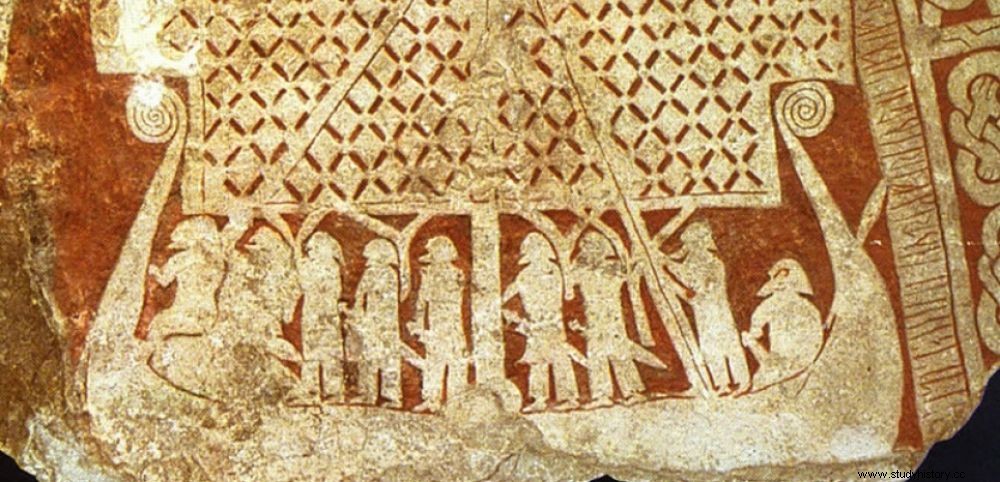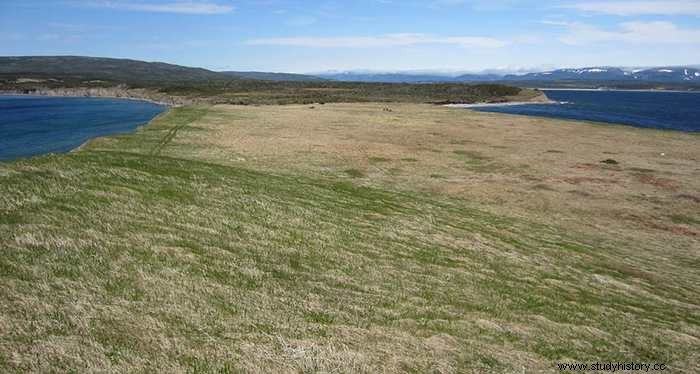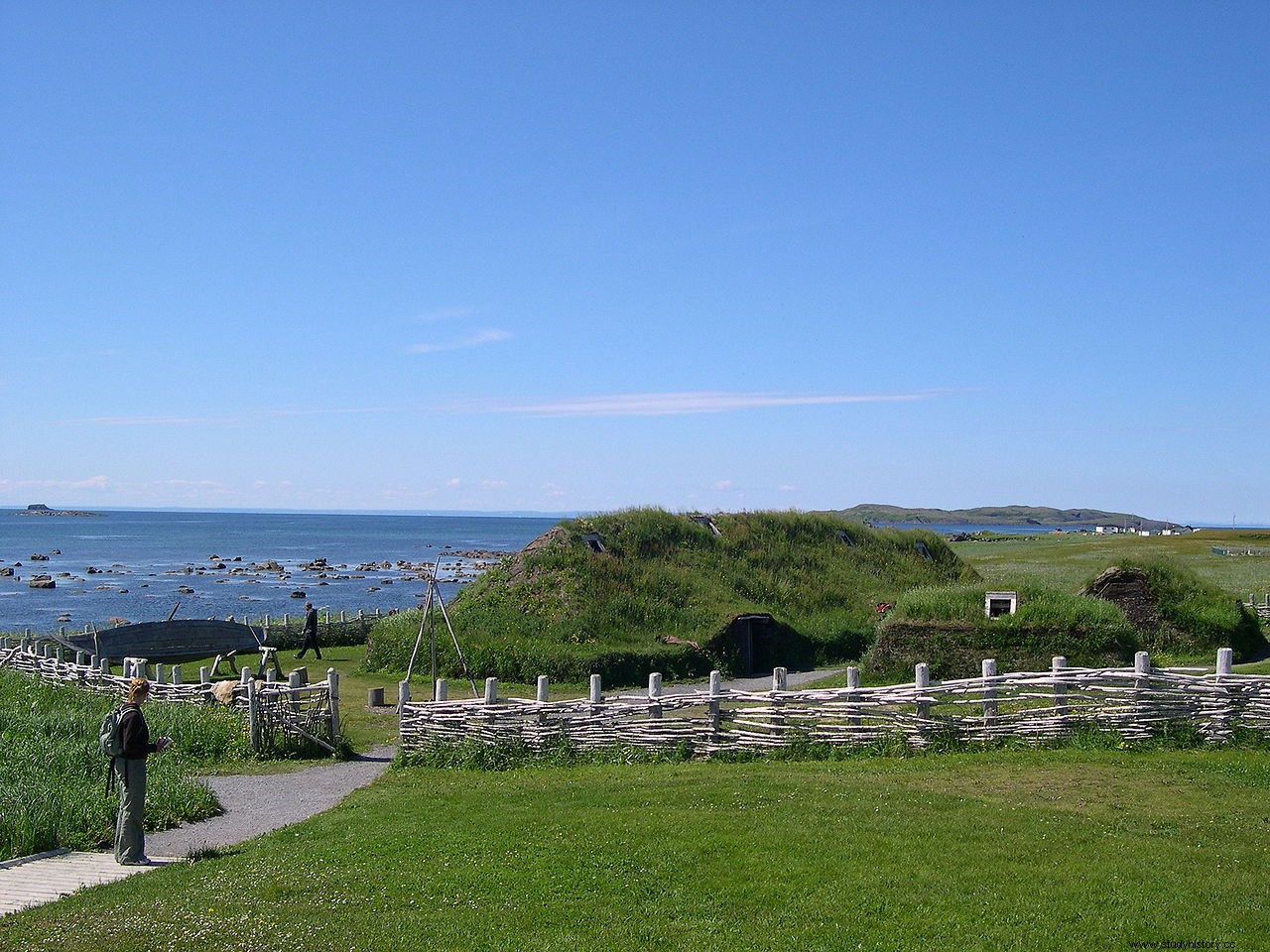 Engraved with a Viking ship, the stone from Tjängvide, Sweden (1.70m high), has was discovered in Gotland in 1844.
Engraved with a Viking ship, the stone from Tjängvide, Sweden (1.70m high), has was discovered in Gotland in 1844. NEWFOUNDLAND. By Odin, have archaeologists unearthed a new Viking site, southwest of the island of Newfoundland, Canada? This Scandinavian settlement, if confirmed, would be the second found on the continent, proving – if it were still needed – that Europeans trod the soil of the New World at least 500 years before Christopher Columbus arrived there. in 1492. On this deposit of Pointe Rosée, at the end of Newfoundland where the waters of the St. Lawrence meet those of the North Atlantic, excavations have revealed traces of charcoal and especially 9 kilos of slag , iron residues, the Vikings using peat to produce iron. The radiocarbon dates obtained by the researchers date the frequentation of these places back to between 800 and 1300 years, a period during which, as the sagas tell * Scandinavian, Viking navigators criss-crossed the North Atlantic. Sporadic voyages to the Canadian east coast are said to have even taken place for at least three centuries after the first visit of the Viking leader Leif Eriksson.

Landscape of Pointe Rosée in Newfoundland, where a new Viking site was discovered. © Greg Mumford
This deposit was spotted in June 2015. Using satellite readings, the American Sarah Parcak, a researcher from the University of Alabama and recent winner of the Ted Prize -for her work in detecting ancient sites through particular satellite images-, had located what appeared to him to be the remains of earthen walls of a Viking building.
The first site of its kind known until then in America is that of Anse-aux-Meadows, still in Newfoundland, 500km north of the current Pointe Rosée and listed on the World Heritage List. On this site studied for several years by Helge Instad, a Norwegian explorer now deceased, a small group of buildings identical in all respects to those occupied by the Vikings in Iceland and Greenland had been unearthed in 1960:the foundations of six dwellings and the remains of a forge, as well as numerous slags, proving there also that iron had been made on the spot. More than 130 objects had been collected (iron rivets, lamps, soapstone utensils, etc.) on this site, which had been occupied for at least thirty years.

The Viking site of Anse-aux-Meadows, Newfoundland (Canada) is on the World Heritage List © UNESCO
Specialists have established that the Vikings of Greenland went even further north than the western colony they had established. Cairns (kinds of burial mounds) have indeed been discovered on Irving Island above 79 degrees north latitude. Other traces have also been located in the Canadian Arctic, as established by Canadian archaeologist Peter Schledermann on Ellesmere Island, not far from the Davis Strait. “Barrels, wood, iron, copper and ship rivets were discovered. It is probably remains of a wrecked boat ". A Viking coin from the 11 e century, with the effigy of King Olaf Kyrre of Norway, has even been found on the coast of Maine.
Multiple proofs of contact
Why didn't the Viking settlements stay put? The question of the rather brutal eclipse of the Vikings is one of the great enigmas that archaeologists are trying to solve today. Because many proofs of contact do exist with the local populations, both in Greenland - with the settlements of Erik the Red in the 10 e century - than in America. The Vikings of Greenland, for example, established barter with the cultures of Dorset and Thule (the "Skraelings of the Sagas, the Little People). Contacts that could well have degenerated into conflicts both with the Inuit, in Greenland, and with the Amerindians, in America.
Nevertheless, of all the reasons invoked to explain the abandonment of these settlements by the Vikings, that evoking their disappearance by too great a change in climatic conditions is the most widely accepted, in particular concerning Greenland. Corings taken in 1998 in the ice by the North Atlantic Biocultural Organization (NABO) thus revealed that between 1343 and 1362, the average temperature there fell terribly. Life would then have become impossible for the settlers. With the cold, the glaciers began to invade the land, draining tons of sand and gravel and reducing the surfaces of pastures. Several years without harvest and without fodder for the animals could have got the better of them. The abandonment of the western colony of Greenland would have been tragic. “Desperate, the last inhabitants ate all their cattle, down to the hooves. They even devoured their dogs. Which proves how hungry they were… “, explained Thomas McGovern, of Hunter College, New York based on the excavations of the Nipaatsoq farm.
The Sagas are mythological stories from medieval Scandinavian literature. The most famous concerning America and Vinland (America) are those mentioned in a description by Adam of Bremen "Gesta Hammaburgensis Ecclesiae Pontificum in 1075, as well as in the saga of the "Islendingabok by Ari Thorgilsson.
